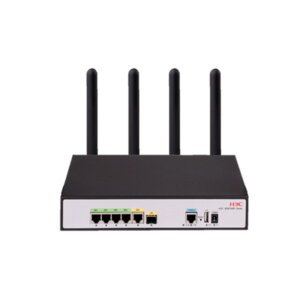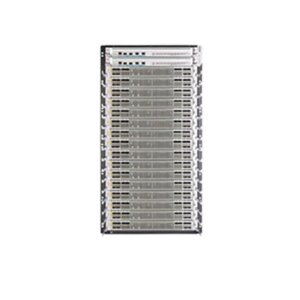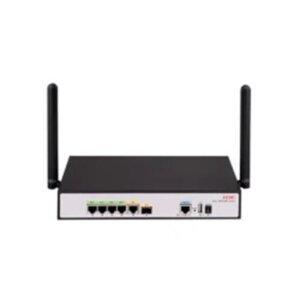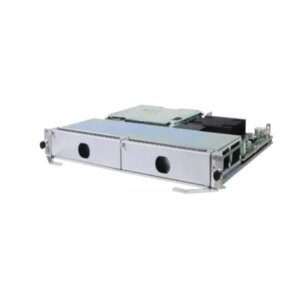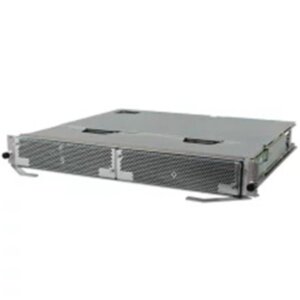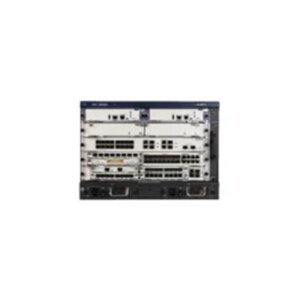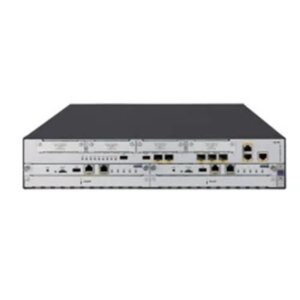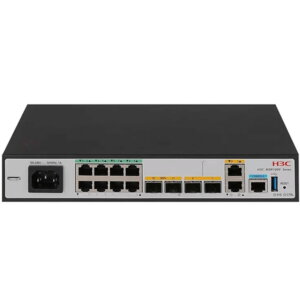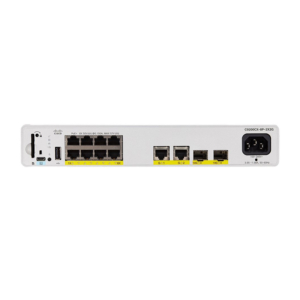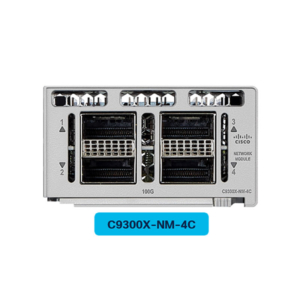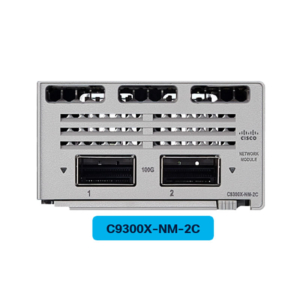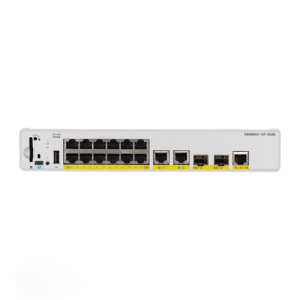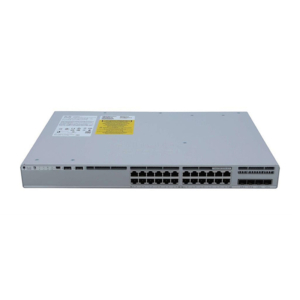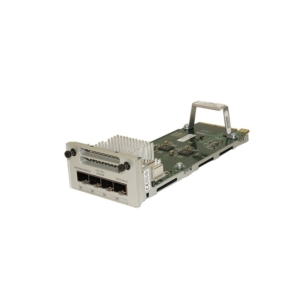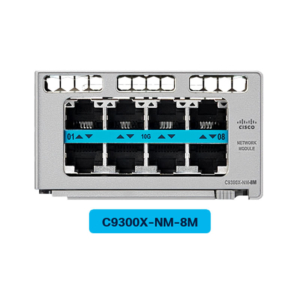Integrating network, compute, and storage capabilities into a single device, H3C SR6602-I AI-powered ICT converged gateways (hereinafter referred to as SR6602-I) enable rapid service delivery and drive business innovations.
 H3C SR6602-I Router Series Data Sheet
H3C SR6602-I Router Series Data Sheet
Hardware specifications
| Item | SR6602-I | SR6602-IE |
| CPU | 8 cores, 2.5 GHz | 12 cores, 2.3 GHz |
| Forwarding Performance In Service (IMIX) | 35Gbps | 42Gbps |
| Built-in WAN port | 6 × 10GE SFP+ ports | 6 × 10GE SFP+ ports |
| Built-in LAN port (supports LAN/WAN switching) | 14 × 10GE SFP+ ports and 12 × GE RJ-45 ports | 14 × 10GE SFP+ ports and 12 × GE RJ-45 ports |
| FIP slot | 1 × FIP slot (supports the FIP-30) | 1 × FIP slot (supports the FIP-30) |
| PCIe slot | 1 | 1 |
| Memory slot | 4CH DDR4 RDIMM slots | 4CH DDR4 RDIMM slots |
| Memory size (default/maximum) | 8 G/128 G | 32 G/128 G |
| Built-in storage | 4 GB | 64 GB |
| External SATA drive slot | 2 × 2.5-inch slots | 2 × 2.5-inch slots |
| Internal M.2 SSD slot | 1 | 1 |
| USB 3.0 port | 1 | 1 |
| Console port | 1 | 1 |
| Open-source application management platforms supported | KVM, Docker | KVM, Docker |
| Maximum power consumption (aggregation mode/converged mode) | 224 W/558 W | 239 W/567 W |
| Power supply redundancy | Supported | Supported |
| Removable fan trays | 2 | 2 |
| Power input voltage | AC: 100 V to 240 V
DC: –48 V to –60 V HVDC: 240 V to 380 V |
AC: 100 V to 240 V
DC: –48 V to –60 V HVDC: 240 V to 380 V |
| Height | 2 RU | 2 RU |
| Dimensions (H × W × D) | 88 × 440 × 480 mm (3.46 × 17.32 × 18.90 in) | 88 × 440 × 480 mm (3.46 × 17.32 × 18.90 in) |
| Operating temperature | Without drives or GPUs: 0°C to 45°C (32°F to 113°F)
With drives or GPUs: 0°C to 40°C (32°F to 104°F) |
|
| Ambient humidity | 5 % RH to 95% RH, noncondensing | |
| Storage temperature | –40°C to +70°C (–40°F to +158°F) | |
| EMC compliance | FCC Part 15 (CFR 47) CLASS A
ICES-003 CLASS A VCCI-3 CLASS A VCCI-4 CLASS A CISPR 22 CLASS A EN 55022 CLASS A AS/NZS CISPR22 CLASS A CISPR 24 EN 55024 EN 61000-3-2 EN 61000-3-3 EN 61000-6-1 ETSI EN 300 386 EN 301 489-1 EN 301 489-17 |
|
| Safety compliance | UL 60950-1
CAN/CSA C22.2 No 60950-1 IEC 60950-1 EN 60950-1/A11 AS/NZS 60950 EN 60825-1 EN 60825-2 FDA 21 CFR Subchapter J GB 4943 |
|
Software specifications
| Item | Specification |
| Layer 2 protocol | Ethernet, Ethernet II, VLAN, 802.1p, 802.1Q, 802.1X, STP (802.1D), RSTP (802.1w), MSTP (802.1s), PPP, PPPoE client, PPPoE server |
| IP services | Unicast/multicast, TCP, UDP, IP option, IP unnumbered, policy-based routing, NetStream
ECMP UCMP |
| IP application | Ping, Tracert, ICMP, DHCP server, DHCP relay, DHCP client, DNS client, DNS proxy, DDNS, NTP, SNTP |
| IPv4 routing | Static routing
Dynamic routing: RIPv1/v2, OSPFv2, BGP, IS-IS Routing policy Multicast routing: IGMPv1/v2/v3, PIM-DM, PIM-SM, MBGP, MSDP |
| IPv6 | IPv6 ND, IPv6 PMTU, IPv6 FIB, IPv6 ACL, NAT-PT, IPv6 tunnel, 6PE
IPv6 tunneling technologies: manual tunneling, automatic tunneling, GRE tunnel, 6to4, ISATAP Static routing Dynamic routing: RIPng, OSPFv3, IS-ISv6, BGP4+ IPv6 multicast: MLDv1/v2, PIM-DM, PIM-SM |
| QoS | LR
Committed access rate (CAR) FIFO, WFQ, CBQ Generic Traffic Shaping (GTS) Traffic classification |
| Security | Portal, 802.1X, IP source guard
Local authentication, RBAC, RADIUS, TACACS ACL, filter, connection limit IKE/IKEv2, IPsec ADVPN L2TP, NATPKI, RSA, SSHv1.5/2.0, URPF, and GRE ARP attack prevention Endpoint Admission Defense (EAD) |
| MPLS | LDP, Static LSP
L3VPN: MCE/multirole host L2VPN: Martini, Kompella, CCC, SVC |
| High availability | VRRP, VRRPv3
Bandwidth-based load balancing and backup IP address-based load balancing and backup NQA collaboration with routing, VRRP or interface backup |
| Management and maintenance | SNMPv1/v2c/v3, MIB, Syslog, RMON
Branch Intelligent Management System (BIMS), deployment from a USB drive CLI, file system, and dual image DHCP, FTP, HTTP, ICMP, UDP public, UDP private, TCP public, TCP private, and SNMP NQA tests Console port login, Telnet (VTY) login, SSH login, FTP login EAA |
| Virtualization | Integration of a highly available and high-performance open virtualization platform that supports third-party operating systems, such as Windows, CentOS, Ubuntu, and RedHat
Complete lifecycle management of virtual machines, including VM creation, modification, startup, suspend, recovery, hibernation, reboot, shutdown, and power-off Monitoring of critical VM resources, such as vCPU, memory, disk I/O, and network I/O Support of high-performance virtualization Ethernet adapter and SR-IOV Support of fast app deployment, app deployment to VMs through a USB drive, and unified app deployment across the network Complete troubleshooting and recovery mechanism Scheduled backup and manual backup Real-time monitoring of VM state VM anomaly detection and auto reboot Integration of Docker and Kubelet functions, allowing deployment of third-party applications on the device as containers through Docker or Kubernetes |
 IT Network Equipment Supplier
IT Network Equipment Supplier

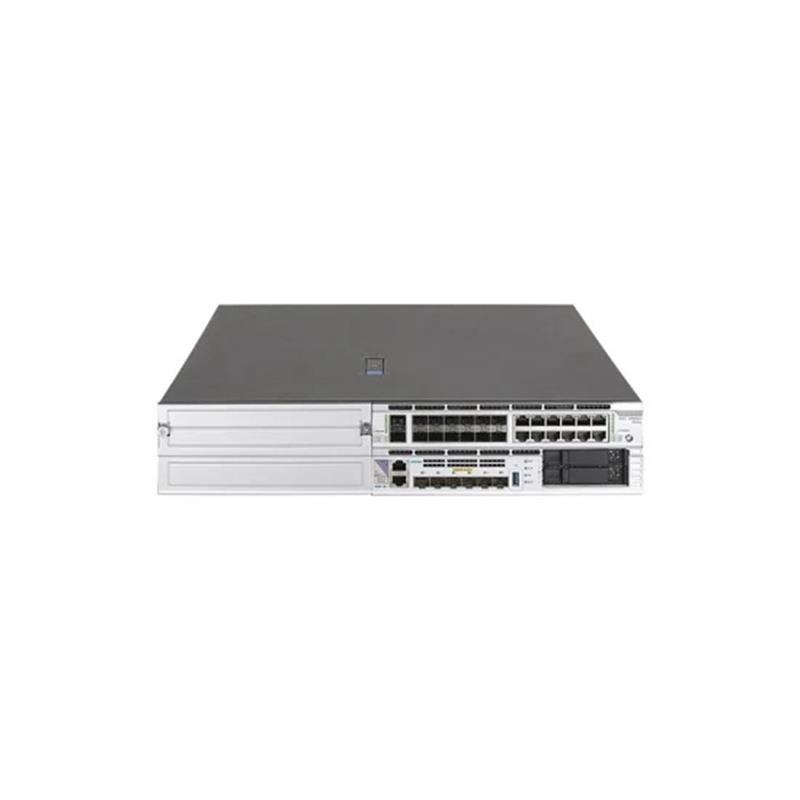
 Is your product original?
Is your product original? Yes, our product is original, we only sell original H3C product.
Yes, our product is original, we only sell original H3C product.



